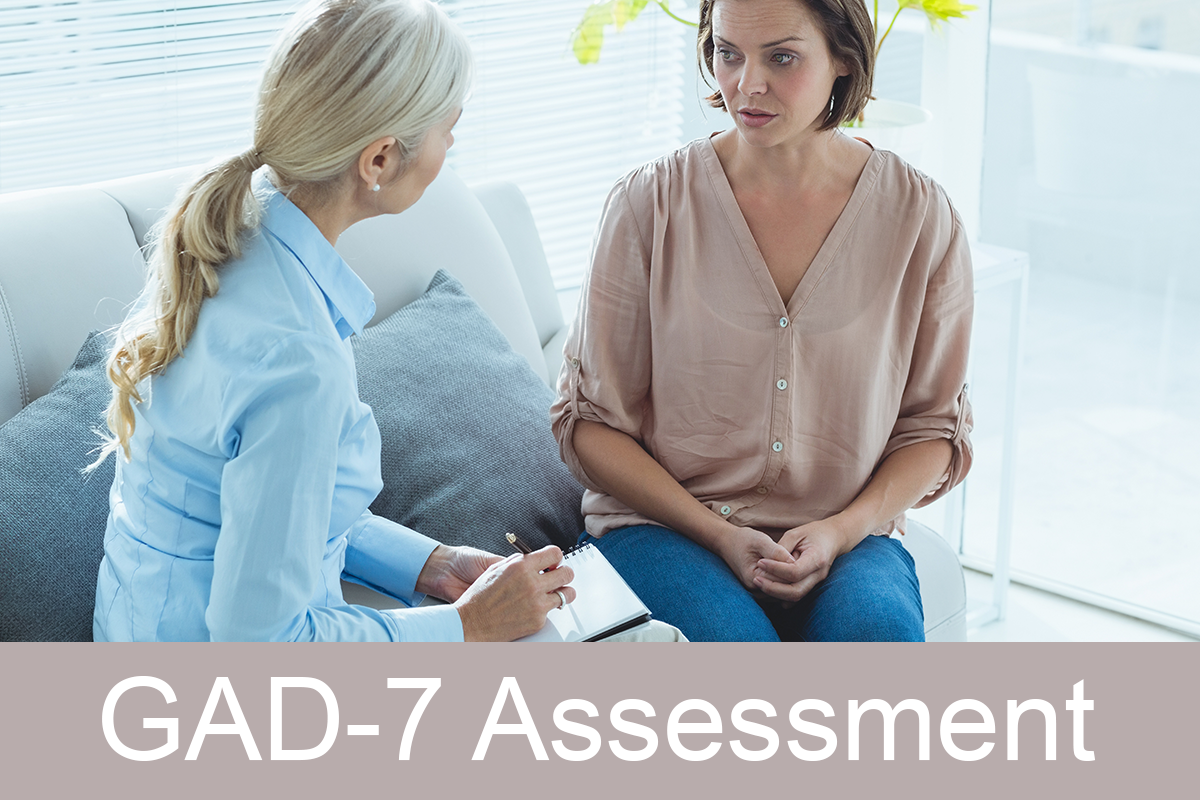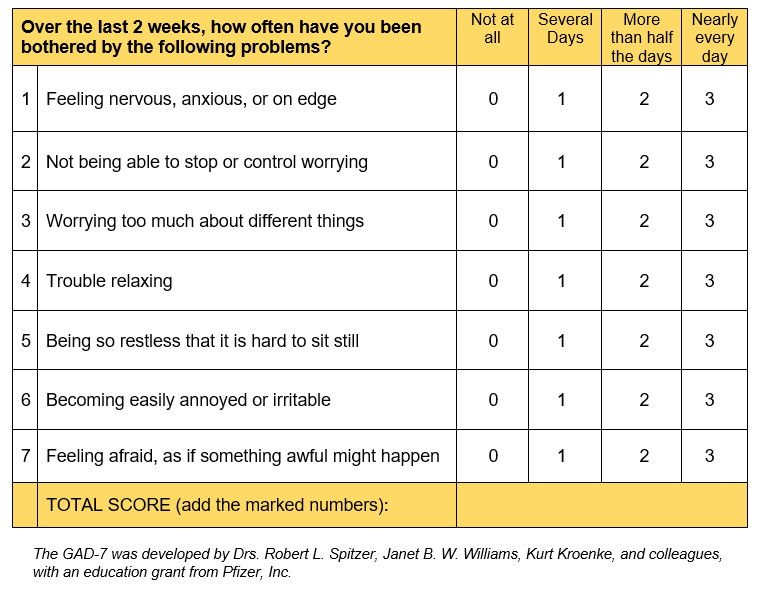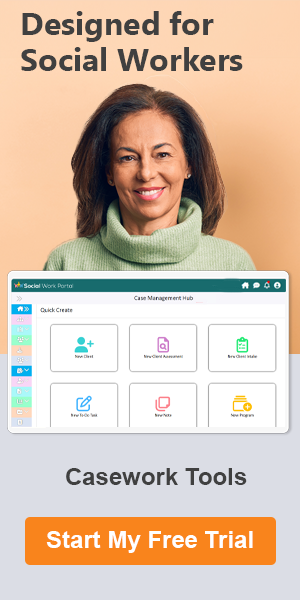Best 2024 Guide for Understanding the GAD 7 Scale for Anxiety Screening
Top 2024 Guide: What You Need to Know about The GAD 7 Anxiety Test | What It Is & How It Works
In the U.S., GAD affects about 6.8 million adults, however, it’s estimated that less than half (43.2%) are receiving any type of treatment. As a result, many have a poorer quality of life and don’t have the tools to deal with their anxiety properly.
Screening for anxiety is common in healthcare environments. Anxiety can impact existing symptoms, as well as cause physical symptoms where none existed. The group of mental disorders termed “anxiety disorders” include generalized anxiety disorder (GAD), social anxiety disorder (SAD), panic disorder (PD), obsessive-compulsive disorder (OCD), post-traumatic stress disorder (PTSD), and phobias.
Why So Many People go Undiagnosed
The time it takes to personally interview a person to identify anxiety is one of the reasons that so many people go undiagnosed and aren’t getting treatment. Doctors’ offices, clinics, and emergency rooms get busy, and an anxiety issue often gets overlooked.
One of the most well-known diagnostic tools used to test for generalized anxiety disorder is the GAD 7 survey, and the GAD 7 anxiety assessment was created to help reduce the time it takes healthcare and mental health professionals to screen a patient for anxiety symptoms.

GAD 7 Screening for Anxiety
See Also: Patient Health Questionnaire (PHQ) Scoring & Assessment Guide
Table of Contents: GAD 7 Assessment
Keep on scrolling down this page to read each section or click any link below to go directly to that section.
- What is the GAD-7 Questionnaire?
- GAD 7 Test Overview
- What’s the Relationship Between PHQ 9 and GAD 7?
- Questions on the GAD 7 Assessment
- GAD 7 Scoring
- GAD 7 Score Interpretation | Proposed Treatments
- Conclusion | GAD-7 Assessment for Anxiety
- FAQ | GAD 7 Form
Don’t Miss: How Does the PHQ 9 Depression Scale Work?
What is the GAD-7 Questionnaire?
The GAD-7 anxiety survey is a seven-question test that is used to detect anxiety and the severity of that anxiety.
It significantly reduces the time it takes to screen individuals for Generalized Anxiety Disorder because it includes just seven questions and can be taken by the patient using a GAD 7 online test. Then all the clinician needs to do is interpret the results and recommend the appropriate treatment.
Are you looking for a platform that has the GAD-7 and other important social work & therapy assessments? Sign up for Client Assessment & Management Hub today and improve the way you work.
The GAD 7 anxiety form is free to use without a copywrite restriction thanks to Pfizer. You’ll see it widely available online as a fillable GAD 7 PDF, a downloadable form, and a GAD 7 online test.
Related: What Social Worker Intake Form Types Are Used the Most by Social Workers?
Do you have any questions about the generalized anxiety disorder 7 item scale or GAD 7 interpretation? If so, contact the Social Work Portal Team.
GAD 7 Test Overview
The seven questions from the GAD 7 tool represent various symptoms or issues that are indicators of anxiety. For each of the seven, the individual will answer how often within the last two weeks they have experienced that thing.
GAD 7 results are based on a numeric value given to each of the frequency options, which are:
- Not at all (0)
- Several days (1)
- More than half the days (2)
- Nearly every day (3)
The GAD 7 score range is based on the total of the seven questions. For example, if someone answered “more than half the days” on all seven questions in a GAD 7 PDF, then the overall test score would be 14.
 |
Get Client Assessment eLearning Modules Join All-in-One Client Management Hub today and go to My Library! |
The GAD 7 anxiety score questionnaire has several advantages over other types of anxiety diagnostic tests:
- It’s based on the DSM IV diagnostic criteria for generalized anxiety disorder.
- It’s fast and easy to take.
- Both PHQ9 and GAD7 scoring have good reliability and procedural validity.
- It saves clinician time.
- It can be self-administered.
- It provides both an indication of anxiety and an assessment of the severity of the anxiety.
Popular Article: What You Need to Know About the HIPAA Form
Do you have any questions about the GAD7 score meaning, GAD 7 PHQ 9 references, or GAD 7 and PHQ 9 scoring? If so, contact the Social Work Portal Team.
What’s the Relationship Between PHQ 9 and GAD 7?
In the 1990’s Pfizer and its research partners Robert Spitzer, Janet Williams, and Kurt Kroenke developed the PHQ9 and GAD7 questionnaire tools. There is a similarity in GAD 7 PHQ 9 scoring in that it follows a similar format of asking how often certain symptoms were experienced in the last two weeks.
The Patient Health Questionnaire (PHQ) identifies depression, whereas the Generalized Anxiety Disorder (GAD) identifies anxiety.
Mental health and healthcare professionals will usually use both tests to aid diagnoses of patients and may use a fillable PHQ 9 and GAD 7 PDF or a PHQ9 and GAD7 online form.
Read More: Guide for General Anxiety Disorder (GAD)
Questions on the GAD 7 Assessment
As we mentioned, there are seven questions on the GAD 7 anxiety screening questionnaire. The test begins by asking: “Over the last 2 weeks, how often have you been bothered by any of the following problems?”
The GAD 7 anxiety form will then give the frequency options we discussed above: Not at all, Several days, More than half the days, and Nearly every day. For each of the seven questions, the respondent will choose one frequency.
These are the questions/issues that the GAD 7 rating scale is based on:
- Feeling nervous, anxious, or on edge
- Not being able to stop or control worrying
- Worrying too much about different things
- Trouble relaxing
- Being so restless that it is hard to sit still
- Becoming easily annoyed or irritable
- Feeling afraid, as if something awful might happen

GAD 7 scale & questions
Are you ready to improve your client engagement effectiveness? Start using Client Management Hub software today.
Are there ever fewer questions?
There is a version of the GAD questionnaire that only has two questions. It’s called the GAD-2. It’s used as a rapid anxiety screening tool in very busy settings. The questions on the GAD 2 are the first two questions from the GAD-7 questionnaire.
The GAD 2 and GAD 7 use similar scoring, but being that it has only two questions, the top score for the GAD-2 is 6. If a person gets a score of 3 or higher on the GAD 2, then it’s recommended they be given the full GAD-7 test.
Related: Popular Social Work Case Notes Formats
Do you have any questions about the GAD 7 and PHQ 9 or the GAD 2 and GAD 7 interpretation? If so, click here to contact the Social Work Portal Team.
GAD 7 Scoring
Each question on the GAD 7 anxiety test can have a score of between 0 and 3. So, the overall GAD-7 scoring range is from 0 to 21.
The GAD 7 scoring guide has four categories of anxiety severity based on the total of the seven questions. The GAD 7 score interpretation is as follows:
- 0 – 4: None to Minimal Anxiety
- 5 – 9: Mild Anxiety
- 10 – 14: Moderate Anxiety
- 15 – 21: Severe Anxiety
Don’t Miss: Facts About Medical Permission Forms
Are you looking for social work assessment tools, like a GAD 7 PDF, or PHQ9 and GAD7 scoring key? Click here to contact the Social Work Portal Team.
GAD 7 Score Interpretation | Proposed Treatments
What is the next step after reviewing the GAD 7 scale for an individual? Treatment recommendations for PHQ9 and GAD7 scoring are included in the documentation for these diagnostic tools.
Here are the proposed treatment next steps for the GAD 7 anxiety questionnaire.
| GAD-7 Score | Depression Severity | Proposed Treatment Actions |
| 0 – 4 | None-minimal | None |
| 5 – 9 | Mild | Monitoring symptoms is recommended, and follow-up as indicated. The GAD-7 can be administered again as part of the follow-up. |
| 10 – 14 | Moderate | The symptoms are clinically significant and warrant further assessment (including diagnostic interview and mental status examination) and/or referral to a mental health professional. |
| 15 – 21 | Severe | The individual’s symptoms of anxiety warrant active treatment. Further assessment (including diagnostic interview and mental status examination) and/or referral to a mental health professional is recommended |
Popular Article: Everything You Need to Know about SOAP Notes
Please let us know if you have any questions about this article about the GAD 7 form and GAD 7 score range. Click here to contact the Social Work Portal Team.
Conclusion | GAD-7 Assessment for Anxiety
Anxiety impacts millions globally and it can range from mild to severe. The GAD-7 scoring assessment is a valuable tool for identifying potential anxiety and determining how severe it may be.
This popular anxiety diagnostic tool is used in multiple medical settings due to the ease of use and speed at which it can be given. Because of their widespread use and reliability, social workers, therapists, and health care professionals should become familiar with both the GAD 7 and PHQ 9 questionnaires.
See Also: How to Find Social Worker Degrees from the Best Social Work Programs
FAQ | GAD 7 Form
What is a GAD 7 Questionnaire?
The GAD 7 test is a short survey designed to identify anxiety and the severity of that anxiety.
What does a GAD 7 score mean?
The GAD 7 scoring guide has four categories of anxiety severity based on the total of the seven questions. The GAD 7 score interpretation is as follows:
•0 - 4: None to Minimal Anxiety
•5 - 9: Mild Anxiety
•10 - 14: Moderate Anxiety
•15 - 21: Severe Anxiety
Is GAD treatable?
Yes, Generalized Anxiety Disorder (GAD) is treatable. Treatments include psychotherapy, medication, and lifestyle changes.
What are PHQ9 and GAD7 scores?
PHQ 9 and GAD 7 come from the same family of tests. The PHQ screens for depression, and GAD screens for anxiety.
GAD 7 and PHQ 9 scoring is done in a similar way, where the severity of the disorder is calculated from the frequency that the individual experiences certain symptoms.
Note: Content on this website (socialworkportal.com) is copyrighted and protected under applicable copyright laws. Unauthorized reproduction, distribution, or use of any content from the website, without explicit written permission, is strictly prohibited. Read: Terms of Use.
Social Work Portal Disclaimer: Social Work Portal is not a social work agency and we do not refer social workers. This web site is provided for educational and informational purposes only and does not constitute providing medical advice or professional social and healthcare services. The information provided should not be used for diagnosing or treating a health problem or disease, and those seeking personal medical advice should consult with ... Read our full disclaimer here: Social Work Portal Disclaimer.

Image sources: Stock.adobe.com




